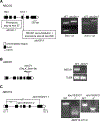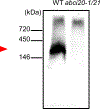Non-intrinsic ATP-binding cassette proteins ABCI19, ABCI20 and ABCI21 modulate cytokinin response at the endoplasmic reticulum in Arabidopsis thaliana
- PMID: 32016506
- PMCID: PMC7346704
- DOI: 10.1007/s00299-019-02503-0
Non-intrinsic ATP-binding cassette proteins ABCI19, ABCI20 and ABCI21 modulate cytokinin response at the endoplasmic reticulum in Arabidopsis thaliana
Abstract
The non-intrinsic ABC proteins ABCI20 and ABCI21 are induced by light under HY5 regulation, localize to the ER, and ameliorate cytokinin-driven growth inhibition in young Arabidopsis thaliana seedlings. The plant ATP-binding cassette (ABC) I subfamily (ABCIs) comprises heterogeneous proteins containing any of the domains found in other ABC proteins. Some ABCIs are known to function in basic metabolism and stress responses, but many remain functionally uncharacterized. ABCI19, ABCI20, and ABCI21 of Arabidopsis thaliana cluster together in a phylogenetic tree, and are suggested to be targets of the transcription factor ELONGATED HYPOCOTYL 5 (HY5). Here, we reveal that these three ABCIs are involved in modulating cytokinin responses during early seedling development. The ABCI19, ABCI20 and ABCI21 promoters harbor HY5-binding motifs, and ABCI20 and ABCI21 expression was induced by light in a HY5-dependent manner. abci19 abci20 abci21 triple and abci20 abci21 double knockout mutants were hypersensitive to cytokinin in seedling growth retardation assays, but did not show phenotypic differences from the wild type in either control medium or auxin-, ABA-, GA-, ACC- or BR-containing media. ABCI19, ABCI20, and ABCI21 were expressed in young seedlings and the three proteins interacted with each other, forming a large protein complex at the endoplasmic reticulum (ER) membrane. These results suggest that ABCI19, ABCI20, and ABCI21 fine-tune the cytokinin response at the ER under the control of HY5 at the young seedling stage.
Keywords: ABC transporter; Cytokinin; Endoplasmic reticulum; HY5; Seedling growth.
Conflict of interest statement
Figures







Similar articles
-
RSM1, an Arabidopsis MYB protein, interacts with HY5/HYH to modulate seed germination and seedling development in response to abscisic acid and salinity.PLoS Genet. 2018 Dec 19;14(12):e1007839. doi: 10.1371/journal.pgen.1007839. eCollection 2018 Dec. PLoS Genet. 2018. PMID: 30566447 Free PMC article.
-
Functional interrelation of MYC2 and HY5 plays an important role in Arabidopsis seedling development.Plant J. 2019 Sep;99(6):1080-1097. doi: 10.1111/tpj.14381. Epub 2019 Jun 24. Plant J. 2019. PMID: 31059179
-
Short Hypocotyl in White Light1 Interacts with Elongated Hypocotyl5 (HY5) and Constitutive Photomorphogenic1 (COP1) and Promotes COP1-Mediated Degradation of HY5 during Arabidopsis Seedling Development.Plant Physiol. 2015 Dec;169(4):2922-34. doi: 10.1104/pp.15.01184. Epub 2015 Oct 16. Plant Physiol. 2015. PMID: 26474641 Free PMC article.
-
ATP-binding cassette transporters in nonmodel plants.New Phytol. 2022 Feb;233(4):1597-1612. doi: 10.1111/nph.17779. Epub 2021 Nov 1. New Phytol. 2022. PMID: 34614235 Review.
-
Promoter profiling of Arabidopsis amino acid transporters: clues for improving crops.Plant Mol Biol. 2021 Dec;107(6):451-475. doi: 10.1007/s11103-021-01193-1. Epub 2021 Oct 21. Plant Mol Biol. 2021. PMID: 34674117 Review.
Cited by
-
Arabidopsis ABCG14 forms a homodimeric transporter for multiple cytokinins and mediates long-distance transport of isopentenyladenine-type cytokinins.Plant Commun. 2023 Mar 13;4(2):100468. doi: 10.1016/j.xplc.2022.100468. Epub 2022 Oct 28. Plant Commun. 2023. PMID: 36307987 Free PMC article.
-
Global View on the Cytokinin Regulatory System in Potato.Front Plant Sci. 2020 Dec 21;11:613624. doi: 10.3389/fpls.2020.613624. eCollection 2020. Front Plant Sci. 2020. PMID: 33408733 Free PMC article.
-
Spontaneous mutation in OsABCI8 caused an albino rice mutant induced by transplanting.Sci Rep. 2025 Jul 25;15(1):27120. doi: 10.1038/s41598-025-12931-6. Sci Rep. 2025. PMID: 40715362 Free PMC article.
-
Identification and Characterization of ATP-Binding Cassette Transporters in Chlamydomonas reinhardtii.Mar Drugs. 2022 Sep 25;20(10):603. doi: 10.3390/md20100603. Mar Drugs. 2022. PMID: 36286426 Free PMC article.
-
2021 update on ATP-binding cassette (ABC) transporters: how they meet the needs of plants.Plant Physiol. 2021 Dec 4;187(4):1876-1892. doi: 10.1093/plphys/kiab193. Plant Physiol. 2021. PMID: 35235666 Free PMC article. Review.
References
-
- Ali T, Bednarska J, Vassilopoulos S, Tran M, Diakonov IA, Ziyadeh-Isleem A, Guicheney P, Gorelik J, Korchev YE, Reilly MM, Bitoun M, Shevchuk A (2019) Correlative SICM-FCM reveals changes in morphology and kinetics of endocytic pits induced by disease-associated mutations in dynamin. Faseb j 33:8504–8518 - PMC - PubMed
-
- Ang LH, Chattopadhyay S, Wei N, Oyama T, Okada K, Batschauer A, Deng XW (1998) Molecular interaction between COP1 and HY5 defines a regulatory switch for light control of Arabidopsis development. Mol Cell 1:213–222 - PubMed
-
- Chang CS, Li YH, Chen LT, Chen WC, Hsieh WP, Shin J, Wu SH (2008) LZF1, a HY5-regulated transcriptional factor, functions in Arabidopsis de-etiolation. Plant J 54:205–219 - PubMed
MeSH terms
Substances
Grants and funding
LinkOut - more resources
Full Text Sources
Other Literature Sources
Molecular Biology Databases

